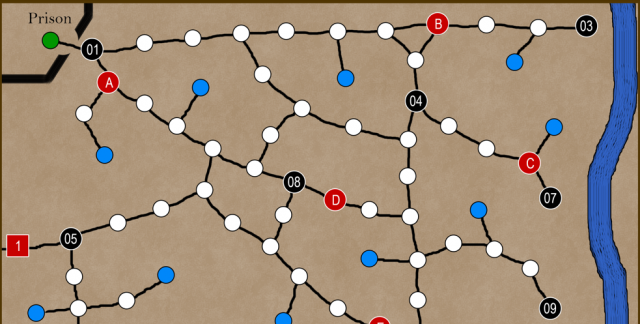I'm working on a map where characters can explore and get harassed by roving patrols. Characters start on Green, then can move from 0-4 spaces each turn. Moving 2 or more spaces creates noise in all directions (1 noise for 2 movement, 2 noise for 3, and 3 noise for 4). Characters who move 3 or 4 are also considered running, and can only keep up this pace for two turns before having to rest by moving only 0 or 1 space. The goal of the characters is to explore the various black numbered locations on the map (each offering different choices, story narrative, skill checks, and rewards). Blue spaces reduce character noise and the patrol's LOS by one.
The patrol's turn begins by drawing two cards from a deck. The deck is comprised of numbers (matching the red square spawn points on the map) and letters (matching the red round destination points on the map), as well as Fast (all patrols move +1 this turn) and Slow (all patrols move -1 this turn) cards. If a letter is drawn and there is no token on the board that matches that letter, then that card is simply discarded and ignored. However, if there IS a matching token, then that token is replaced with a token drawn from the bag (thus changing the patrol's destination, making the patrols far less predictable).
[Example: Spawn 1 is drawn from the patrol deck. The A patrol token is drawn from the token bag and placed on the square Spawn 1 space. Then the A token moves three spaces towards red destination point A. (Any other patrol tokens currently on the board move 3 spaces closer to their destinations too.) On turn 2, the A card is drawn. from the patrol deck The E token is drawn from the bag, replacing the A token on the board. The E token moves 3 spaces towards red destination point E (and again, all other patrol tokens move towards their destinations as well.)]
If a patrol moves within two adjacent spaces to a character, or moves over a noise token (created when characters move 2 or more spaces), then the patrol makes that character their new destination.
Overall, there are some pros and cons to this system...
THE GOOD: The mix of escalating patrols with new spawns, patrols changing speed and direction, etc., make for some pretty tense moments where characters have to run for their lives, hide, and sometimes get caught.
THE BAD: After card draws and swapping destinations, as more patrols enter the board, each one has to move towards their specific destination. Because the maps are big (I could only upload about 1/3 of one side of the full map due to pic size limitations), there are patrol units that are quite far away from any character that must still swap or move each turn. Though simple enough, it is still tedious with no real point to move these patrols. Also, when congested, some characters must "hide" (usually on a blue space), and wait for patrols to clear out before exploring again. This can result in several stuck characters with idle turns, depending on circumstance. Additionally, the bulk of time is spent drawing patrol cards and moving patrol units (rather than player's moving their own tokens).
Here is one possible solution I've considered...
SOLUTION 1: To alleviate inconsequential patrols being managed that are out of range, I could break each map into sectors, with different decks and draw bags managing each sector. These sectors would only activate when a character enters them. The downside: more components (up to six decks, and six draw bags) to setup and manage. And it does nothing to alleviate idle turns where a character is stuck hiding waiting for patrols to pass.
Any other thoughts you can suggest to streamline this system?






Thanks for taking a stab at it! Each player will control from 1 to N characters, and characters will group in teams. But there's no global pool of Action Points - each team gets up to 4 movement. There is almost always some team movement somewhere, but some teams will take longer to progress than others depending on patrol circumstances.
However, you sparked an idea.
One problem I was thinking was that every team needed to cross the river and be together on the other side to trigger the end game sequence. But if the first team triggers the end game, then all other teams simply catch up for the finale (potentially leaving unexplored sections due to time constraints). I can actually picture that cinematically and it would make sense in the broader scheme of things.
Thanks for your inspiration!
-Tom